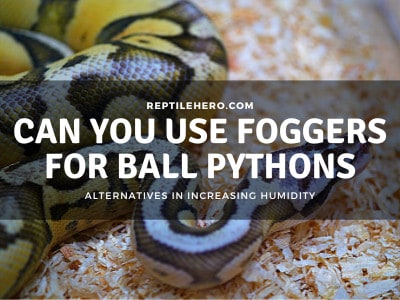Can You Use Heat Tape for Ball Pythons?
Heat tapes are one of the cheapest heating devices for a ball python. As a casual keeper, you may not have encountered using heat tapes as a heating alternative. So you’re likely wondering if it’s safe—should you start using one today?
In general, heat tapes can be used for ball pythons as long as it is reptile-grade. Heat tapes are commonly used by keepers with multiple ball pythons and breeders of different scales due to their affordable price and flexible capabilities.
Reptile heat tapes are more flexible compared to other lightless heaters. But what are some of the risks when using one? And why are they so popular among breeders? Continue reading until the end to find out more!
Who Uses Heat Tapes for Ball Pythons? Why?
Heat tapes are often used by owners who need a heating element for multiple reptiles, like ball pythons. It is commonly used by breeders due to its length and flexibility in rack setups.
Ball pythons breeders like how they can stretch out the tape throughout their long racks of ball pythons. They can also regulate the whole section with only 1 or 2 thermostats which are cost-efficient.
But if you are going to give your ball python the “best care” possible, the usage of plastic tubs and racks are not recommended.
In choosing the right set-up, you must check whether it can accommodate the snake’s size, enrichment, day-night cycle, and other husbandry needs. These parameters cannot be achieved by using most racks and tub systems.
Reptile heat tapes work through the conversion of electricity to heat.
The electrical current from the metal bus bars is transported as heat through the heating elements in the middle (black bars). The whole device is covered in plastic laminate.

Reptile-safe heat tapes consist of 3 main parts: metal bus bars, a heating element, and a plastic laminate.
4 Advantages of Using Heat Tapes for Ball Python Tanks
Heat tapes are used by ball python keepers because of advantages like: 1) affordability, 2) versatility, 3) long lifespan, and 4) lightless heating.
1. Affordability
Reptile heat tapes are one of the cheapest heating sources for a ball python. They only cost roughly 2–6 dollars per foot.
In comparison, a 12 x 12 heat mat can cost around 15–20 dollars while the same size of heat tape costs around 6 bucks or even less.
2. Versatility
Most reptile heat tapes can operate efficiently up to 50 feet as a side or under heating. They can also be bent slightly which makes them flexible to work with. Heat tapes can also be cut to the desired size.
Multiple individual strips can also be connected to each other which means they would only require one outlet before being connected to the thermostat.
If the heat tape you bought is too long, you can cut it to whichever length you want, as long as it is within the maximum capacity of the thermostat.
3. Long Lifespan
Heat tapes have an average lifespan of 4–6 years. Although there are reports of lower and higher numbers.
Those who experienced heat tape failures found it can be as short as 1–2 years only, although this can also be due to a failed thermostat and not the tape itself.
Some keepers have also used heat tapes for more than 7 years, without encountering any problems.
As a testament to a heat tape’s lifespan, some companies even offer a 5-year warranty in case there are any defects, problems, or malfunctions regarding their product.
4. Lightless Heating
Heat tapes do not emit light which makes them perfect for nighttime usage. A lightless heat source will not disrupt the day and night cycle of ball pythons.
Heat tapes also do not drastically affect the humidity in an enclosure so it is great to use during winter or when the climate is already dry.
5 Problems of Using Heat Tapes for Ball Python Tanks
In contrast, there are also problems and dangers that come with using heat tapes for ball pythons, namely: 1) fire hazards, 2) belly burns, 3) DIY wiring, 4) inadequate heating, and 5) inconsistent heating.
1. Fire Hazards
As a result of bad electrical work, loose wirings on heat tapes can lead to fire caused by sparks. This can also cause the heat tape to have a shorter lifespan.
Improper insulation and exposed metal bus bars can also cause fires but most of the time, it will only lead to an electrical shock.
Warning: Reptile heat tapes are not water resistant!
Moisture build-up can also damage the device and can cause fire/ electrical hazards. So if you are to use one, make sure to check if the plastic laminate is sealed properly to avoid getting it wet.
2. Belly Burns
Unregulated heat tapes can also cause belly burns to a ball python. The highest temperature a heat tape can get is around 125°F, which if left in close contact for a long period (2 hours or more), can cause burns to ball pythons.
Ball pythons have less receptive heat receptors when compared to us humans. That is why they are prone to getting mild-harsh belly burns because they realize that it is too hot, too late.
Pro Tip: All heat devices, including heat tape, must always be connected to a thermostat. This minimizes the risk of device failure which is optimal for a ball python since they are prone to burns.
>>Learn more about thermal burns in our article about ball pythons getting too hot.
3. DIY Wiring
Heat tapes can come with an installed wire, but for large orders, the wiring will most likely need to be done by the recipient. Such extra work may be inconvenient for ball python owners, especially those with no experience with electrical work.
For some keepers, doing electrical work can be a bit daunting.
If there is also a specific length you would like to use, then most probably you are going to cut it yourself and deal with the electrical work.
This will also depend on where you are going to buy the heat tape. Other retailers sell all the accessories needed and can install the wiring for you, while others do not offer these kinds of services.
4. Inadequate Heating
Like most lightless heaters, heat tapes do not produce infrared A and B which is the heat that penetrates deeply into the body of a reptile. This means that heat tapes cannot be used as a primary source of heat.
Another issue with using reptile heat tape is the type and amount of heat it can produce in an enclosure with a substrate that’s 2 inches thick or deeper.
This device can only be used at its best with a substrate half an inch deep and less.
More importantly, if you are going to provide the best care for your scaly pet, I recommend providing a heat source that produces IRA and/or IRB like halogen lamps and deep heat projectors.
You can also provide a low-level UVB light (5%) because it is proven that they can benefit from it [1]. When provided with a UVB, ball pythons can simulate D3 better, which results in
5. Inconsistent Heating
Heat tapes do not produce heat consistently over their entire surface. There will be spots in the heat tape with varying temperatures, either 5% higher or lower.
For example, if the heat tape is set to 100°F, then the varying temperatures can be 95 or 105°F throughout the tape.
That is why it is recommended to test the heating setup for a couple of hours before putting your ball pythons into the heated enclosure.
The 5% variance can also be lessened when using shorter sections of heat tape.
3 Things to Know Before Buying Heat Tapes for Ball Pythons
Before buying heat tapes for ball pythons, there are 4 things to take note of: 1) size, 2) wattage and 3) type.
1. Size
As a general rule, the reptile heat tape should cover at least 25% of the length of an enclosure. Heat tapes have different widths to accommodate various enclosure sizes.
| Width Size (Inches) | Enclosure Length (Inches) |
| 3 | 12 |
| 4 | 16 |
| 6 | 24 |
| 12 | 48 |
| 21 | 64 |
The most used sizes for ball python tanks are the 6 and 12-inch heat tapes. The 6-inch ones are used for hatchlings to juvenile ball pythons while the 12-inch ones are typically used for adults.
For example, the recommended adult ball python enclosure is 48 inches in length. The 25% of 48 is 12, thus the recommended heat tape for it is 12 inches wide.
2. Wattage
Reptile heat tape wattages are helpful in gauging which thermostat it is compatible with. Wattage per foot is the common measurement of power consumption in heat tapes.
| Width Size (Inches) | Wattage (per Foot) | Recommended Max Length (500W Thermostat) |
| 3 | 4 | 90 ft and below |
| 4 | 6 | 80 ft and below |
| 6 | 12 | 60 ft and below |
| 12 | 23 | 30 ft and below |
| 21 | 30 | 20 ft and below |
As observed from the table above, the recommended length is only accommodated by 70% power of the thermostat for example: 500W ➗4W=125ft.
But the recommended length is only 90ft, why is that?
This recommendation is implemented to prolong the life of the thermostat itself. Imagine operating it at max power, this can cause a shorter lifespan which may come as an unexpected temperature hazard to your ball pythons [2].
Using Multiple Heat Tape Strips
Although not recommended, you can maximize the length of the heat tape to the limit of the thermostat. For example, 125ft for the 3-inch tape based on the data in the table above.
But keep in mind that longer heat tape sections have a higher chance of malfunctions and inconsistent heat output. This is why the recommended wattage accommodation is 70% to minimize risks.
Warning: Only heat tapes with the same wattage can be connected together to a single thermostat outlet. This is done to avoid extreme temperature gradients and overheating on the heat tapes.
If you connect an extension cord of different wattages to one thermostat outlet, then there will be problems regarding the heat output. For example, a 100°F to a 12-inch one can be around 110-115°F in the 6-inch heat tape, and vice-versa.
Not only will this lead to overheating and malfunctions on the connected heat tapes, but it can also lead to temperature problems for the ball pythons.
3. Type
Reptile heat tapes are the only type of heat tape that should be used for ball pythons. Heat tape brands such as THG and Flexwatt are the most recommended by ball python keepers and breeders.
In terms of installation, both are generally the same but have different metals used for the bus. Some brands offer a copper one, while some have a tin-plated copper bus.
Copper ones are more prone to corrosion/ oxidation which causes a slight decrease in their conductivity. In relation to this, tin-plated ones have higher resistance to corrosion.
Possible corrosions can be caused by moisture and bacteria (iron and sulfate)
Warning: Never use non-reptile heat tapes. These tapes are used to prevent freezing in pipes which means that their unregulated heat can start at 200°F and upwards to 1500°F. Regulating this kind of tape using reptile-grade thermostats can lead to malfunctions.
For the THG heat tape, you can get it here on Reptilebasics where they offer them in bulk, wire installation, and pre-cut sections. For Flexwatt heat tape, you can visit their official website here.
Fun Fact: Depending on the brand, heat tape temperatures can go up to the range of 110-125°F.
6 Factors to Consider in Using Heat Tapes for Ball Python Tanks
Before using a reptile heat tape, there are crucial factors to consider to ensure a ball python’s safety. These factors include: 1) insulation, 2) cutting, 3) thermostat, 4) enclosure material, 5) adhesives, and 6) placement.
1. Insulation
For reptile heat tapes, insulation is the most important aspect to prevent fire and temperature hazards. For electrical insulation, rubber and electrical tapes are the best ones to use.

2. Cutting
When cutting a reptile heat tape, the cut should be in the white space in between the heating elements (black lines). Using a sharp cutting tool is a must to prevent damage to the plastic laminate of the tape itself.
Warning: Never cut a heat tape that is plugged in! This can cause electrocution through your cutting tool.
In addition to this, rolled and overlapped heat tapes should not be turned on due to possible breaking of the product and electricity hazards.
3. Thermostat
Like all heating sources, reptile heat tapes must be connected to a thermostat to avoid overheating and maintain the proper temperature.
Investing in a good quality proportional thermostat is recommended, rather than buying a cheap one from a dubious store or brand.
The amount of possible injuries and fatalities to your ball pythons greatly outweighs a costly investment in a thermostat. This investment is a priority especially when it is used for multiple enclosures.
4. Enclosure material
For reptile heat tapes, materials like glass, plastic, and wood are safe if used properly. Due to electrical hazards, it is not recommended to place the heat tape near a conductor like metal.
Pro Tip: The surface temperature of the enclosure must be tested for a few hours using a temperature gun before putting any live animals in.
The safest enclosure material will be plastic—more specifically, polyvinyl chloride (PVC). It insulates electricity while slightly insulating the heat to lessen the risk of high temperatures for the ball python.
Glass and wood can also be paired with a heat tape. But with a wooden enclosure, be wary of faulty wirings that may cause sparks and start a fire.
5. Adhesives
To secure the reptile heat tape, the adhesives that can be used are foil tape, duct tape, and other heat-conducting tapes.
Don’t worry, none of these will be in contact with your slithering ball python so there’s no chance of it sticking to their scales and causing injuries.
As an added precautionary measure, do not use any conducting tape on top of the metal bus bar. Although it is insulated by the plastic laminate, there is still a possibility of electrical shocks due to a scenario like a scratched plastic.
6. Placement
It is prohibited to place reptile heat tape inside an enclosure. Placing it inside can cause higher risks of burns to ball pythons. It can also get wet through urine or water when placed inside.
Heat tapes can only be placed externally—under or at the back of the ball python enclosure.
Warning: Heat tapes must not carry the weight of an enclosure. This can cause heat build-up which leads to damage and overheating of the tape. Direct rubbing of the enclosure to the heat tape can also peel the lamination off the tape.
For the thermostat probe, it is recommended to place it on the surface above the heat tape, if you are using a stand-alone enclosure. However, when using the heat tape for rack systems, it is important to place it on top of the tape itself.
This is done to let the thermostat directly control the temperature of the heat tape rather than the temperature inside the bins used. This will ensure that the heat tape is regulated properly and avoid over or underheating an enclosure.
You can then adjust the temperature of the heat tape based on the temperature reading inside one of the bins.
2 Steps to Installing Heat Tapes for a Ball Python Enclosure
There are two things to keep in mind before installing the heat tape for ball pythons enclosures: 1) wiring and 2) enclosure setup.
1. Wiring
To connect the heat tape to a wire, there are 3 methods: 1) solder, 2) rivet, and 3) clip. The aforementioned list starts from the most to the least effective wiring method for ball python tank heat tapes.
1. Solder
It is observed that the best connection is achieved through soldering the wires directly to the copper bus. However, this method is harder to do compared to other methods and needs additional materials like a soldering iron and solder.
Just remember not to touch molten solder as it can be very hot and can cause blisters.
After soldering, insulation must be done by attaching rubber or electrical tape in the wire area and at the metal bus ends.
2. Rivet
The rivet method is an easy way to secure the connections to the wire and the heat tape itself. The materials needed include rivets, crimping pliers, hole puncher, flat eyelet, cord, and insulating tapes.
After the wires have been connected, you need to make sure that it is in a very tight fit with no way of getting loose. Then, insulation is always a must on the wires and the metal bus ends.
One of the reasons why the rivet method is less efficient compared to the soldering one is due to installation errors. Commonly, people make the mistake of having untightened connections which will lead to lesser power output and possible electrical accidents.
3. Clip
The easiest way to connect the wires to the heat tape is through the clamp method. The materials needed only consist of copper clips, crimping pliers, cords, and insulating tapes.
If you have clipped the wire properly through the plastic lamination and into the metal bus, then you can have a good connection. But compared to the other two methods this is the least secure.
There are often issues where the clips did not bite properly, or they became loose due to improper tightening. Such mistakes can also cause a weak connection and even result in fire and electrical hazards.
2. Enclosure Setup
After the reptile heat tape is properly wired, it can be placed at the bottom or the sides of a ball python enclosure. The installation will vary depending on the setup: 1) single enclosure and 2) rack system.
1. Single Enclosure
For a single ball python enclosure, a heat tape can be placed under it or at a side. Larger heat tape widths (8 or 12 inches) are usually used for a stand-alone enclosure.
To secure the heat tape, you can use foil tape or duct tape, making sure that it is flushed and there are no curves or loose ends when installing it.
When placing heat tape under the enclosure, make sure that it does not carry the weight of the enclosure itself. You can provide rubber supports to the base of the enclosure to avoid it crushing the heat tape.
2. Rack System
In using a reptile heat tape in a ball python rack system, the tape itself can be placed under a bin or at the back panel of the rack. Back heating is easier to do compared to the belly heat installation.
The width usually used for belly heat in rack set-ups ranges from 4 to 6-inch heat tapes, while larger ones, 12–24 inches in width, are used for back heating.
For back installation, you can utilize a large size heat tape (12 or 24-inch) and then cut it to match the height of the back panel. Finally, tape it flush onto the back of the ball python rack.
Pro Tip: Drill some ventilation holes on the back panel of the rack. This will provide the heat tape breathing room to prevent heat build-up.
For belly heat installation, you can cut the tape into different sections and wire them together, or cut a long strand then fit it through an entire rack in an s-like pattern.

Pro Tip: A minimum of ⅛ inch of breathing room is required from at least one side of the heat tape to allow airflow and prevent heat build-up.
Further Questions
Why does heat tape have different temperatures?
Heat tapes have different temperatures based on their usage. Industrial heat tapes generally have higher heat output because they are used in cooling pipes and for heating water. While reptile-grade ones have lower max heat output to provide optimal heat for reptiles such as ball pythons to minimize the potential of thermal burns.
Can you use self-regulating heat tape for ball pythons?
Self-regulating heat tapes cannot be used for ball pythons. The tapes of this kind can have temperatures ranging from 300-1000°F and above. The recommended heat tapes for ball pythons are reptile-grade ones like THG and Flexwatt.
Summary of Using Heat Tapes for Ball Pythons
Overall, heat tapes are used for ball pythons due to their cheap price, flexibility, long lifespan, and lightless heating. Conversely, they have disadvantages like requiring electrical work and producing insufficient and inconsistent heating. They can also cause risks like fire hazards, electrical hazards, and thermal burns.
Before buying using a heat tape for ball pythons, potential users must be aware of the following: proper sizing, correct wattage, optimal type, and crucial factors that ensure the animal’s safety.
When installing a heat tape, wiring must be done first. It can be done through soldering, rivets, and clips. After that, the wired heat tape can be installed under or at the side of either a stand-alone enclosure or a rack system.






